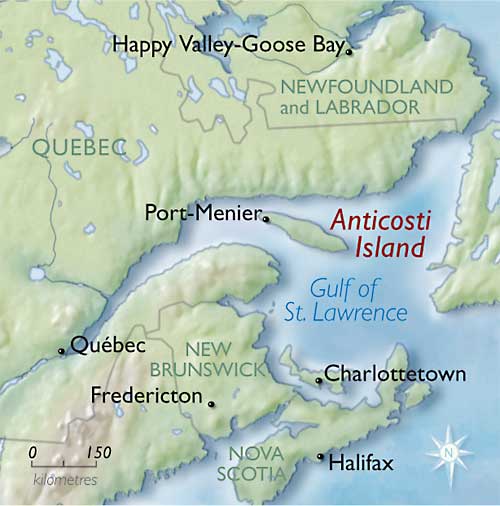Anticosti is another of the celebrated islands situated in the Gulf of St. Lawrence at a spot where the river mixes with the cold waters of the Artic.
Sparsely populated, the only large settlement on Anticosti Island is at Port-Menier on the western coast. Unfortunately we anchored at the other end of the island and as a consequence saw very little except the fog and rolling mist
Aboriginal peoples first visited the island for fishing and hunting. Jacques Cartier ‘discovered’ it for Europeans in 1534, although it remained without any permanent population until Louis IV gave it to the Jolliet family in 1680.
The family retained it until 1753 and during that time it was used for harvesting timber.
The French chocolatier Henri Menier used his vast fortune to acquire the 140 mile long island in the late 19th century. He did so for use as his own private game and hunting reserve
He imported Bison, Elk, Red Fox, Silver Fox and Beaver as well as introducing a population of Virginia White Tailed Deer who, without natural predators, have expanded exponentially. Today there are more than 160,000 deer on the island, accounting for a density of approximately 7 deer per square mile one of the highest such densities in the world. The Bison, Elk and most of the other imports fell foul of the onslaught of lead fired at them by shooting parties lead by Menier.
Menier built a settlement at Port Menier in the western end of the island and it is around there that most of the island’s current population of 280 live.
Anticosti Provincial Park straddles most of the island, much of which is now devoted to parkland or nature conservation. But it remains a popular spot for those with concessions to hunt deer and fish in the 24 turbulent rivers where Atlantic Salmon is the most sought after prize.
Having anchored far away from the small port, the ship’s Russian Master, decided that it was far too rough for a beach landing. After a two hour stint bouncing in an uncomfortable anchorage we weighed anchor and set sail towards Boone Bay on the west coast of Newfoundland.
We are grateful to Destination Canada, Air Canada and ship operators One Ocean Expeditions for kindly hosting us on this trip

